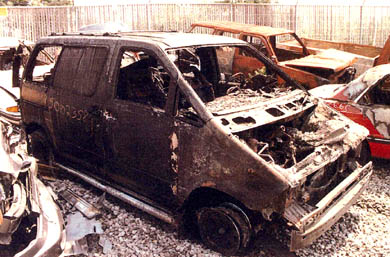
Figure 1
Figure 1 is a photo of a vehicle that was at the ori-
gin of a fire in a garage that was badly damaged and
a relatively large property loss. Burn patterns (1.)
traced the fire origin to the alternator shown in Fig-
ure 2. There was unusually severe melting of the al-
ternator housing near the rectifier unit, suggesting
that an electrical malfunction had occurred in the al-
ternator, causing the fire. Since the vehicle was
parked and had cooled down, other potential causes
of the fire were eliminated. The original alternator
had recently been replaced with a rebuilt alternator
by a garage mechanic near the insuredís home.

Figure 2
Figure 3 is a simplified drawing of a typical auto-
mobile alternator. The engine turns a belt driven
pulley, which turns the rotor shaft supplying electri-
cal energy to the battery and other electrical com-
ponents. The brushes, which transfer electricity
from the rotor shaft, wear over time and are re-
placed during rebuilding of the alternator. The recti-
fier, an electronic component, converts the alternat-
ing current to direct current and is a part that is of-
ten replaced during rebuilding.

Figure 3
Detailed inspection of the alternator yielded evi-
dence that the fire started in the rectifier assembly.
According to the rebuilder, the rectifier assembly
was replaced with an aftermarket unit as part of the
remanufacturing operation. The aftermarket rectifier
did not conform to the original equipment manufac-
turerís specification. In fact, it was discovered that
the rebuilder was not authorized to refurbish alter-
nators by the original equipment manufacturer. The
rebuilder did not perform any reliability testing or
sampling of the product for quality control pur-
poses. The rebuilder merely reverse engineered the
rectifier assembly by matching an off the shelf unit
with the expected output of an original equipment
manufactured rectifier.
Typically, original equipment manufacturers au-
thorize rebuilding of automotive components as
long as certain specifications are met. Specifications
include reliability testing, performance testing and
sample testing of a certain percentage of rebuilt
units. If a rebuilder remanufactures product with-
out following original equipment manufacturerís
specifications and without any alternative reliability
testing, then there is a high probability that the reli-
ability of the unit will be substandard. The particu-
lar rebuilder of the alternator in Figure 2 had ex-
perienced a very high premature failure rate with
customers.

Figure 4
Additional inspection of the alternator revealed an
improperly assembled brush as shown in Figure 4.
The right (red) arrow points to an alternator brush
that was in good condition. The left arrow (black) is
the other brush that was sheared in half, a result of
improper assembly of the alternator. Although this
defect did not directly cause the fire, the alternator
would have failed much earlier than expected. This
attested to the degree of substandard workmanship
performed by the alternator rebuilder. It is apparent
in this particular case that the reverse engineering of
the rectifier assembly was substandard and lead to
the malfunction that caused the loss. The alternator
rebuilder eventually settled with the insurer of the
automobile and garage.
1. ďAutomotive Vehicle Fire Analysis,Ē Charles C.
Roberts, Jr. Ph.D., P.E., Roberts Publishing,
2004.
FOR TECHNICAL ARTICLES CONTACT CLAIMS MAGAZINE AND ASK
FOR A REPRINT OF A PAST TECHNICAL NOTEBOOK ARTICLE
CLAIMS MAGAZINE
BACK TO C. ROBERTS CONSULTING ENGINEERS HOME PAGE,
WWW.CROBERTS.COM

Figure 2

Figure 3
Detailed inspection of the alternator yielded evi-
dence that the fire started in the rectifier assembly.
According to the rebuilder, the rectifier assembly
was replaced with an aftermarket unit as part of the
remanufacturing operation. The aftermarket rectifier
did not conform to the original equipment manufac-
turerís specification. In fact, it was discovered that
the rebuilder was not authorized to refurbish alter-
nators by the original equipment manufacturer. The
rebuilder did not perform any reliability testing or
sampling of the product for quality control pur-
poses. The rebuilder merely reverse engineered the
rectifier assembly by matching an off the shelf unit
with the expected output of an original equipment
manufactured rectifier.
Typically, original equipment manufacturers au-
thorize rebuilding of automotive components as
long as certain specifications are met. Specifications
include reliability testing, performance testing and
sample testing of a certain percentage of rebuilt
units. If a rebuilder remanufactures product with-
out following original equipment manufacturerís
specifications and without any alternative reliability
testing, then there is a high probability that the reli-
ability of the unit will be substandard. The particu-
lar rebuilder of the alternator in Figure 2 had ex-
perienced a very high premature failure rate with
customers.

Figure 4
Additional inspection of the alternator revealed an
improperly assembled brush as shown in Figure 4.
The right (red) arrow points to an alternator brush
that was in good condition. The left arrow (black) is
the other brush that was sheared in half, a result of
improper assembly of the alternator. Although this
defect did not directly cause the fire, the alternator
would have failed much earlier than expected. This
attested to the degree of substandard workmanship
performed by the alternator rebuilder. It is apparent
in this particular case that the reverse engineering of
the rectifier assembly was substandard and lead to
the malfunction that caused the loss. The alternator
rebuilder eventually settled with the insurer of the
automobile and garage.
1. ďAutomotive Vehicle Fire Analysis,Ē Charles C.
Roberts, Jr. Ph.D., P.E., Roberts Publishing,
2004.
FOR TECHNICAL ARTICLES CONTACT CLAIMS MAGAZINE AND ASK
FOR A REPRINT OF A PAST TECHNICAL NOTEBOOK ARTICLE
CLAIMS MAGAZINE
BACK TO C. ROBERTS CONSULTING ENGINEERS HOME PAGE,
WWW.CROBERTS.COM

Figure 4
1. ďAutomotive Vehicle Fire Analysis,Ē Charles C. Roberts, Jr. Ph.D., P.E., Roberts Publishing, 2004.
FOR TECHNICAL ARTICLES CONTACT CLAIMS MAGAZINE AND ASK
FOR A REPRINT OF A PAST TECHNICAL NOTEBOOK ARTICLE
CLAIMS MAGAZINE
BACK TO C. ROBERTS CONSULTING ENGINEERS HOME PAGE,
WWW.CROBERTS.COM
WWW.CROBERTS.COM